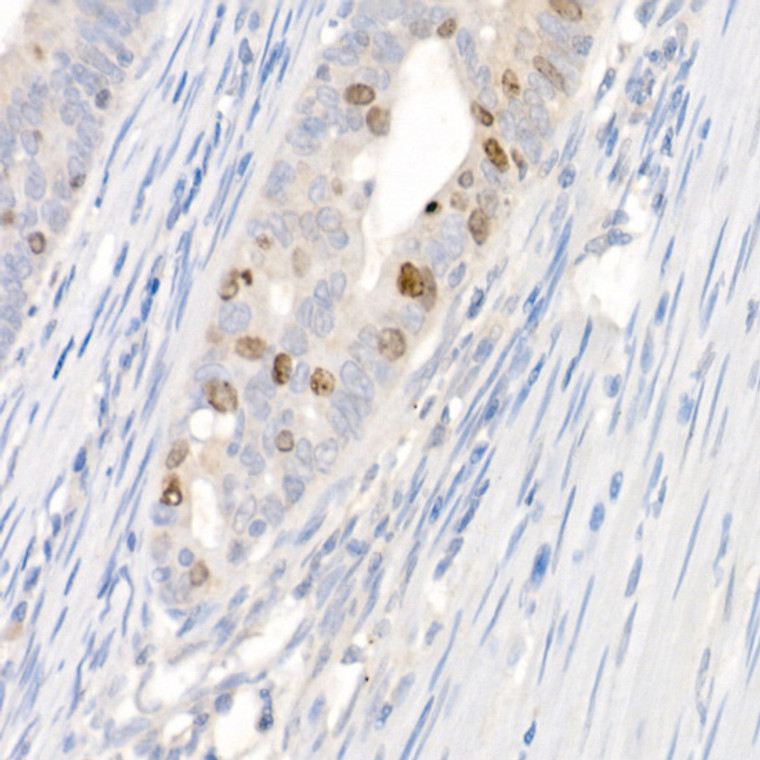| Host: |
Rabbit |
| Applications: |
WB/IHC |
| Reactivity: |
Human/Mouse/Rat |
| Note: |
STRICTLY FOR FURTHER SCIENTIFIC RESEARCH USE ONLY (RUO). MUST NOT TO BE USED IN DIAGNOSTIC OR THERAPEUTIC APPLICATIONS. |
| Short Description: |
Rabbit polyclonal antibody anti-Survivin (1-142) is suitable for use in Western Blot and Immunohistochemistry research applications. |
| Clonality: |
Polyclonal |
| Conjugation: |
Unconjugated |
| Isotype: |
IgG |
| Formulation: |
PBS with 0.01% Thimerosal, 50% Glycerol, pH7.3. |
| Purification: |
Affinity purification |
| Dilution Range: |
WB 1:100-1:500IHC-P 1:50-1:200 |
| Storage Instruction: |
Store at-20°C for up to 1 year from the date of receipt, and avoid repeat freeze-thaw cycles. |
| Gene Symbol: |
BIRC5 |
| Gene ID: |
332 |
| Uniprot ID: |
BIRC5_HUMAN |
| Immunogen Region: |
1-142 |
| Immunogen: |
Recombinant fusion protein containing a sequence corresponding to amino acids 1-142 of human Survivin (NP_001159.2). |
| Immunogen Sequence: |
MGAPTLPPAWQPFLKDHRIS TFKNWPFLEGCACTPERMAE AGFIHCPTENEPDLAQCFFC FKELEGWEPDDDPIEEHKKH SSGCAFLSVKKQFEELTLGE FLKLDRERAKNKIAKETNNK KKEFEETAEKVRRAIEQLAA MD |
| Tissue Specificity | Expressed only in fetal kidney and liver, and to lesser extent, lung and brain. Abundantly expressed in adenocarcinoma (lung, pancreas, colon, breast, and prostate) and in high-grade lymphomas. Also expressed in various renal cell carcinoma cell lines. Expressed in cochlea including the organ of Corti, the lateral wall, the interdental cells of the Limbus as well as in Schwann cells and cells of the cochlear nerve and the spiral ganglions (at protein level). Not expressed in cells of the inner and outer sulcus or the Reissner's membrane (at protein level). |
| Post Translational Modifications | Ubiquitinated by the Cul9-RING ubiquitin-protein ligase complex, leading to its degradation. Ubiquitination is required for centrosomal targeting. Deubiquitinated by USP35 or USP38.leading to stabilization. In vitro phosphorylation at Thr-117 by AURKB prevents interaction with INCENP and localization to mitotic chromosomes. Phosphorylation at Thr-48 by CK2 is critical for its mitotic and anti-apoptotic activities. Phosphorylation at Thr-34 by CDK15 is critical for its anti-apoptotic activity. Phosphorylation at Ser-20 by AURKC is critical for regulation of proper chromosome alignment and segregation, and possibly cytokinesis. Acetylation at Lys-129 by CBP results in its homodimerization, while deacetylation promotes the formation of monomers which heterodimerize with XPO1/CRM1 which facilitates its nuclear export. The acetylated form represses STAT3 transactivation. The dynamic equilibrium between its acetylation and deacetylation at Lys-129 determines its interaction with XPO1/CRM1, its subsequent subcellular localization, and its ability to inhibit STAT3 transactivation. |
| Function | Multitasking protein that has dual roles in promoting cell proliferation and preventing apoptosis. Component of a chromosome passage protein complex (CPC) which is essential for chromosome alignment and segregation during mitosis and cytokinesis. Acts as an important regulator of the localization of this complex.directs CPC movement to different locations from the inner centromere during prometaphase to midbody during cytokinesis and participates in the organization of the center spindle by associating with polymerized microtubules. Involved in the recruitment of CPC to centromeres during early mitosis via association with histone H3 phosphorylated at 'Thr-3' (H3pT3) during mitosis. The complex with RAN plays a role in mitotic spindle formation by serving as a physical scaffold to help deliver the RAN effector molecule TPX2 to microtubules. May counteract a default induction of apoptosis in G2/M phase. The acetylated form represses STAT3 transactivation of target gene promoters. May play a role in neoplasia. Inhibitor of CASP3 and CASP7. Essential for the maintenance of mitochondrial integrity and function. Isoform 2 and isoform 3 do not appear to play vital roles in mitosis. Isoform 3 shows a marked reduction in its anti-apoptotic effects when compared with the displayed wild-type isoform. |
| Protein Name | Baculoviral Iap Repeat-Containing Protein 5Apoptosis Inhibitor 4Apoptosis Inhibitor Survivin |
| Database Links | Reactome: R-HSA-141444Reactome: R-HSA-2467813Reactome: R-HSA-2500257Reactome: R-HSA-4615885Reactome: R-HSA-5663220Reactome: R-HSA-6785807Reactome: R-HSA-6803205Reactome: R-HSA-68877Reactome: R-HSA-8951664Reactome: R-HSA-9648025 |
| Cellular Localisation | CytoplasmNucleusChromosomeCentromereCytoskeletonSpindleKinetochoreMidbodyLocalizes At The Centromeres From Prophase To MetaphaseAt The Spindle Midzone During Anaphase And A The Midbody During Telophase And CytokinesisAccumulates In The Nucleus Upon Treatment With Leptomycin B (Lmb)A Xpo1/Crm1 Nuclear Export InhibitorLocalizes On Chromosome Arms And Inner Centromeres From Prophase Through MetaphaseLocalizes To Kinetochores In MetaphaseDistributes To The Midzone Microtubules In Anaphase And At TelophaseLocalizes Exclusively To The MidbodyColocalizes With Aurkb At Mitotic ChromosomesAcetylation At Lys-129 Directs Its Localization To The Nucleus By Enhancing Homodimerization And Thereby Inhibiting Xpo1/Crm1-Mediated Nuclear Export |
| Alternative Antibody Names | Anti-Baculoviral Iap Repeat-Containing Protein 5 antibodyAnti-Apoptosis Inhibitor 4 antibodyAnti-Apoptosis Inhibitor Survivin antibodyAnti-BIRC5 antibodyAnti-API4 antibodyAnti-IAP4 antibody |
Information sourced from Uniprot.org
12 months for antibodies. 6 months for ELISA Kits. Please see website T&Cs for further guidance










